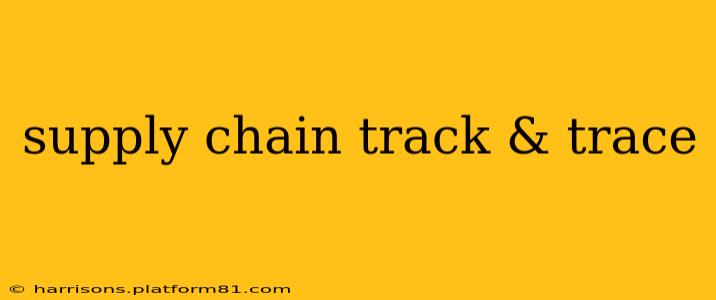The modern business landscape demands real-time visibility into every stage of the supply chain. Gone are the days of relying on infrequent updates and guesswork. Supply chain track and trace technology offers a solution, providing unparalleled transparency and control over the movement of goods from origin to destination. This comprehensive guide will explore the intricacies of supply chain track and trace, examining its benefits, implementation strategies, and future trends.
What is Supply Chain Track & Trace?
Supply chain track and trace refers to the use of technology to monitor and record the location and status of goods throughout the entire supply chain. This encompasses everything from raw material sourcing and manufacturing to warehousing, transportation, and final delivery to the end customer. Data is collected at various checkpoints using a variety of technologies, offering a holistic view of the supply chain’s performance.
This enhanced visibility allows businesses to proactively manage potential disruptions, optimize logistics, and ultimately improve customer satisfaction. The technology goes beyond simple location tracking; it provides insights into temperature, humidity, and other crucial environmental factors that can impact product quality.
Benefits of Implementing Supply Chain Track & Trace
The advantages of implementing a robust track and trace system are numerous and far-reaching:
- Improved Efficiency: Real-time data allows for streamlined processes, reduced delays, and optimized resource allocation.
- Enhanced Visibility: Gain complete transparency into your supply chain, identifying bottlenecks and inefficiencies quickly.
- Reduced Costs: Prevent losses due to theft, damage, or delays. Optimized routing and improved efficiency lead to lower transportation and warehousing costs.
- Better Inventory Management: Accurate inventory tracking minimizes stockouts and overstocking, leading to cost savings and improved customer service.
- Increased Customer Satisfaction: Provide customers with real-time updates on their orders, enhancing transparency and trust.
- Improved Supply Chain Resilience: Proactive identification of potential disruptions allows for timely mitigation strategies, enhancing the resilience of your supply chain.
- Enhanced Security: Track and trace systems offer enhanced security measures, reducing the risk of theft or diversion of goods.
- Regulatory Compliance: Many industries face strict regulatory requirements for tracking and tracing products. A robust system ensures compliance.
How Does Supply Chain Track & Trace Work?
Various technologies underpin modern track and trace systems. These include:
- Barcode and RFID Technology: These technologies provide basic item-level tracking.
- GPS Tracking: Real-time location data is crucial for tracking shipments in transit.
- IoT Sensors: These sensors monitor environmental conditions and product integrity throughout the supply chain.
- Blockchain Technology: Offers enhanced security and transparency by recording all transactions on a distributed ledger.
- Cloud-Based Platforms: Centralized data storage and analysis provide real-time insights.
Data from these sources is often integrated into a single platform, providing a unified view of the supply chain. Sophisticated analytics can then be applied to identify trends, predict potential problems, and optimize processes.
What Technologies are Used in Supply Chain Track & Trace?
This question is addressed above, under "How Does Supply Chain Track & Trace Work?". The technologies mentioned there – barcode and RFID, GPS, IoT sensors, blockchain, and cloud-based platforms – are the core components of most modern track and trace systems. The specific technology implemented depends on the specific needs and budget of the business.
How Much Does Supply Chain Track & Trace Cost?
The cost of implementing a track and trace system varies significantly depending on several factors, including the size and complexity of the supply chain, the technologies used, and the level of integration required. Smaller businesses might opt for simpler solutions with lower upfront costs, while larger enterprises often invest in more sophisticated, integrated systems. The long-term cost savings from improved efficiency and reduced losses often outweigh the initial investment.
What are the Challenges of Implementing Supply Chain Track & Trace?
While the benefits are clear, implementing a successful track and trace system presents several challenges:
- Integration Complexity: Integrating various technologies and data sources can be complex and time-consuming.
- Data Security: Protecting sensitive data is paramount. Robust security measures are essential to prevent breaches.
- Cost of Implementation: The initial investment can be significant, especially for larger organizations.
- Lack of Standardization: The absence of industry-wide standards can hinder interoperability between different systems.
- Resistance to Change: Adopting new technologies can require significant changes in processes and workflows, which can face resistance from employees.
The Future of Supply Chain Track & Trace
The future of supply chain track and trace is bright. We can expect to see further integration of advanced technologies, such as artificial intelligence (AI) and machine learning (ML), to enhance predictive capabilities and automate processes. The growing adoption of blockchain technology promises enhanced security and transparency. The convergence of these technologies will drive further improvements in efficiency, resilience, and customer satisfaction. The focus will continue to shift towards creating more sustainable and ethical supply chains.
This comprehensive overview provides a solid understanding of supply chain track and trace. By embracing these technologies, businesses can gain a competitive edge in today's dynamic market.
